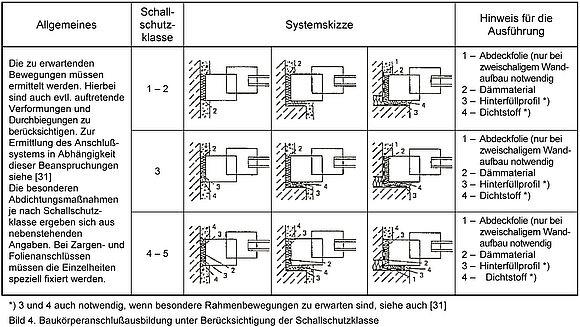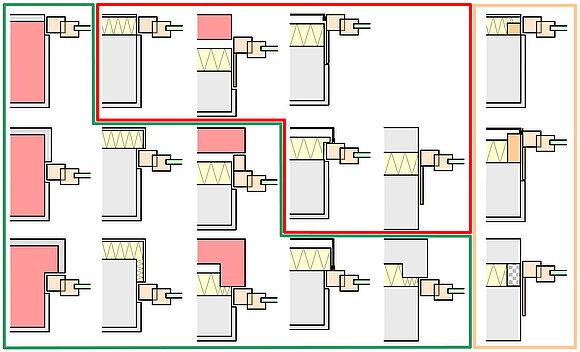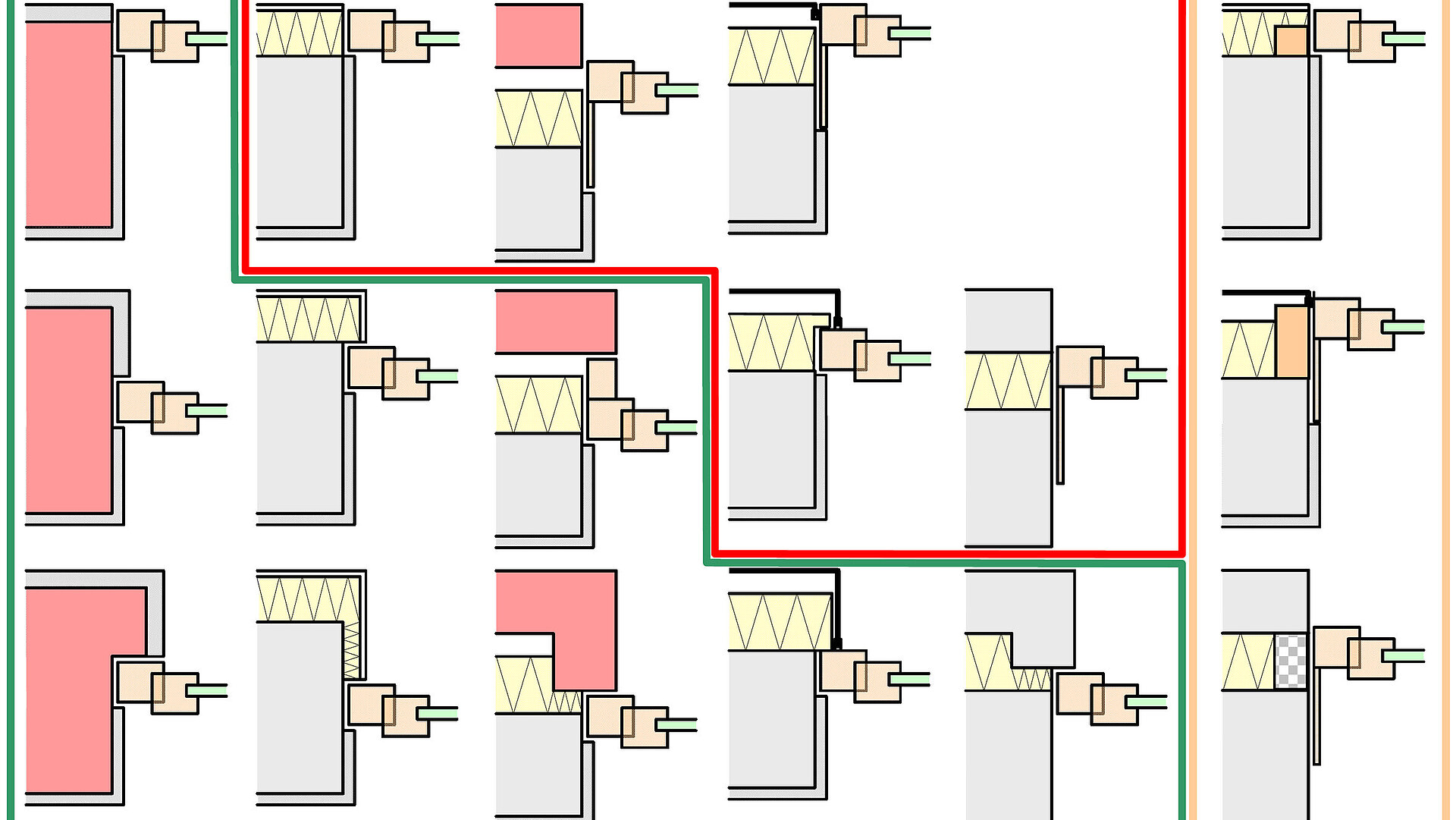Reading time: 1 minute
For purposes of documentary evidence on the construction site, the quality of windows in their installed state is always an important consideration, because it is the quality of the window within the building that the customer directly experiences and hence is particularly interested in. Design tools and construction contracts are therefore generally focused on maximising the quality of the window in its installed state.
Until a few years ago, the issue of a window’s sound insulation when installed was given relatively little attention. But this is changing as buildings need to be built ever more energy-efficiently. The increasing use of External Thermal Insulation Cladding Systems (ETICS) requires different construction techniques that affect the way the window is installed, shifting it into the insulation zone. From the point of view of sound insulation, this creates problematic installation situations that need to be planned for on a case-by-case basis.
A wider range of installation systems are now available, but some provide only a low level of sound insulation – for example multifunctional insulating strips, which often offer considerably worse sound insulation of joints than conventional sealing systems.
The “Installation guide” ([6]) and the planned new version of DIN 4109 both address these issues. A great deal has been said on this topic at previous editions of the Rosenheim International Window & Facade Conference in relation to installation and sound insulation of joints. Based on these insights, the new version of DIN 4109 will set out a method identifying critical installation situations and offering design tips for how to obtain documentary evidence in such cases.
Current situation
The following documents provide information and set out requirements for windows in their installed state.
VDI 2719-1987
As far back as 1987, the Association of German Engineers (VDI) published a guide entitled “Acoustic Insulation of Windows and Additional Window Fittings”, containing information about the sound insulation of windows when installed. The long-established German “sound reduction classes” refer to windows in their installed state as described in Table 2 of this guide (see Table 1); it also defines various requirements for installation.

The guide says the following about installation:
“For sound reduction classes 1 or 2 it is generally sufficient to tightly fill or stuff the wall connecting joint with soundproofing material.
For sound reduction classes 4 or 5, non-setting sealing compound must additionally be applied to both sides of the joint to ensure leaktight backfilling with soundproofing material.
No general statements can be made regarding sound reduction class 6.
Note: all sealing work must be carried out in accordance with the instructions of the manufacturers of the sealants, sealing profiles, membranes, films, foils and foams used, and according to the installation instructions of the window manufacturer. Special care must be taken when designing/detailing and executing these tasks in the area of the window sill.”

It should be noted that some of this information is out of date and no longer reflects the current state of the art, particularly that relating to the position of the sealant joint.
DIN 4109:1989
DIN 4109:1989 addresses the issue in less detail than VDI 2719-1987. Its requirements relating to the sound insulation of windows refer to the “required weighted sound reduction index” (“erf. Rw”), which does not take account of flanking sound transmission. The installed component must be ready for operation.
The calculation value Rw,R is used for verifying conformity with the requirements; this figure can be taken from either tables or test evidence. Rw,R is determined from the laboratory test result, following deduction of a 2 dB tolerance. No indication is given of what this general empirical tolerance value covers: possible variations in sound insulation may be caused by measurement inaccuracies, product variation, or differences in the way the window is installed – but none of these are specified.
So DIN 4109 does not describe the window’s installed state in the building. This creates a gap in the verification chain, because calculation does not take account of the installation method. In many cases it may well be that deducting the 2 dB tolerance is sufficient to account for any variations in installation method. But the example of the window installed in the insulation zone in particular shows that there are installation methods where this is not covered.
The “Installation guide”
The 5th and most recent version of the “Guide to designing and installing windows and entry doors in new build and refurbishment” (the “Installation guide”) contains a chapter on sound insulation that lists the various methods available for the sound insulation of windows. It also contains calculation methods to enable designers to take account of the method used to install the window, involving the “joint sound reduction index” (see below).
In addition it provides tabulated values for the sound insulation of joints of certain product groups, and an overview of “favourable” and “critical” installation situations of windows and for subframes. Favourable and critical installation situations are denoted in the diagram below by a green or red border respectively.

and entry doors” [6]
Sound insulation of joints
The ift Rosenheim has been tackling the issue of sound insulation of joints for many years (since 1992), in various publications and tests. The installation guide is based on measurements conducted at the ift, as is the latest version of DIN 4109. A full list of relevant publications and tests will not be provided here; instead, delegates are referred to the transcripts of the ift’s Window & Facade and Door Conferences, and other specialist ift publications.
New version of DIN 4109
As mentioned, DIN 4109 (Sound insulation in buildings) is currently undergoing revision – and has been for almost 20 years. The most recent drafts submitted to the public for consultation date from 2013. “Comments-resolution” meetings have been conducted, and DIN is now incorporating the outcomes of these meetings into the standard.
The standard will be published in four parts: Requirements, Calculation methods, Parts catalogue, and Verification by measurement. The Parts Catalogue (Bauteilkatalog) in turn will consist of six sub-documents.
Specific information regarding the parts group of windows can be found in Parts 1 (Requirements), 2 (Calculation Methods), and 35 (Parts Catalogue – Components).
Requirements
Requirements for the airborne sound insulation of external components can be found in chapter 7 of the new version of DIN 4109-1. These requirements are expressed in terms of the total weighted sound reduction index (R’w,ges) of the external component. The content of the table corresponds to that of the old Table 8 from the 1989 edition of the standard, and still refers to the “required resulting sound reduction index” (erf. R’w,res). So, as far as the requirements for windows go, essentially nothing is different in the new version DIN 4109.
Calculation methods
As for calculation methods, the situation will now be quite different from before. Previously a tolerance of generally 2 dB was subtracted from the measured values to give the calculated value Rw,R, which was used to verify conformity with the requirements for sound insulation.
It is anticipated that the new version of the standard will introduce a new, single method that can be applied uniformly to all components. According to this method, a calculation is first carried out for the sound transmission of the overall assembly (e.g. external wall with window and roller shutter box), without any deductions. Only then is a safety value deducted to give a figure that can be used to check that the requirements have been met:
- Determination of the total sound reduction index of a construction situation for external components as per chapter 4.4
- Deduction of a “safety factor” (uprog) to allow for inaccuracies
R’w – k × uprog ≥ erf. R’w in dB
In most cases uprog = 2 dB. The variable “k” is the coverage factor for the inaccuracies; for purposes of DIN 4109, k has a value of 1.
The new version of the standard thus marks the end of the line for the old calculated value Rw,R.
The installation situation is factored in with the help of the definitions in the installation guide, i.e. a red border in Fig. 2 means that a given installation situation is “critical”. In these cases the total weighted sound reduction index takes account of the joint sound insulation, so input variables will include data for the installation joint.
Parts catalogue
The old Addendum 1 will be replaced by DIN 4109, Parts 31-36. Part 35 is the section that deals with building components; it provides data for components such as windows and glass infill panels, and for the sound insulation of joints. Input data are already available to allow for the effect of installation joints when designing windows in their installed state. Similarly, the “Installation guide” provides a collection of examples with their corresponding joint sound reduction indices.
For special designs, it is also possible to incorporate the results from tests such as those available from the ift Rosenheim.
Conclusion
Thanks to the additional design details in the new version of DIN 4109, it will in future be possible to design more accurately the sound insulation provided by a window in its installed state, in contrast to the current system involving the deduction of a very generalised tolerance. Elements of the new standard that will be particularly helpful in reducing the design risk include information on “critical” installation positions in the insulation zone – which are very commonly encountered today – and the provision of a design tool for assessing these situations.
Bibliography
- VDI 2719:1987-08
Acoustic insulation of windows and additional window fittings
Beuth Verlag GmbH, Berlin - DIN 4109: 1989-11
Sound insulation in buildings – Requirements and testing
Beuth Verlag GmbH, Berlin - DIN 4109 Supplement 1: 1989-11
Sound insulation in buildings – Construction examples and calculation methods
Beuth Verlag GmbH, Berlin - DIN 4109 Supplement 1/A1:2003-09
Sound insulation in buildings – Construction examples and calculation methods; Amendment A1
Beuth Verlag GmbH, Berlin - DIN EN 14351-1: 2010-8
Windows and doors – Product standard, performance characteristics – Part 1: Windows and external pedestrian doorsets without resistance to fire and/or smoke leakage characteristics
Beuth Verlag GmbH, Berlin - Guide to designing and installing windows and entry doors in new build and refurbishment
RAL-Gütegemeinschaft Fenster und Haustüren e.V., 03/2014 - Saß, B., Schumacher R.
Schalldämmung von Fugen [Sound insulation of joints], Daga 2003 - DIN EN 12354-3:2000
Building acoustics – Calculation of the acoustic properties of buildings on the basis of component properties – Part 3: Airborne sound insulation against outdoor sound
Beuth Verlag GmbH, Berlin - ift Guideline SC-01/02
Bestimmung des Fugenschalldämm-Maßes [Determination of sound reduction index]
ift Rosenheim 2002 - DIN EN ISO 10140-1:2010
Acoustics - Laboratory measurement of sound insulation of building elements – Part 1: Application rules for specific products (ISO 10140-1:2010 + Amd.1:2012 + Amd.2:2014)
Beuth Verlag GmbH, Berlin - Reproduced with permission by Verein Deutscher Ingenieure e.V. Only the latest version (latest date of issue) of VDI standards should be applied. They are available from Beuth Verlag GmbH, Burggrafenstraße 6, 10787 Berlin, Germany.


